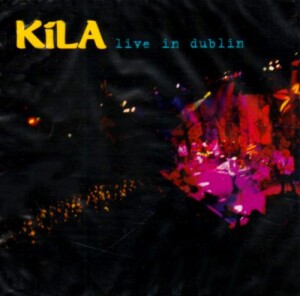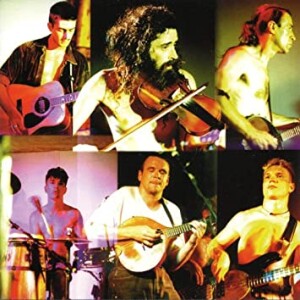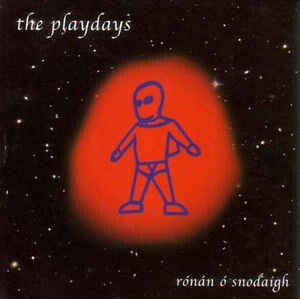 This reviewer anticipated both of these live releases with great pleasure, while the solo effort from Kíla frontman Ronan O’Snodaigh came as a pleasant surprise in the post. I’ve enjoyed both bands live on several occasions, and sought out their recordings. Both build on a bedrock of native tradition, interpreting it through an electronica lens. Oddly enough both groups play highly scripted pieces that sound spontaneous — or else both are masters of spontaneously producing the identical piece in repeat performances. “Hypnofolkadelia” proclaims a T shirt I used to own, before it wore out. “Who are those hippies?” asked a friend when Live in Dublin came up on the playlist.
This reviewer anticipated both of these live releases with great pleasure, while the solo effort from Kíla frontman Ronan O’Snodaigh came as a pleasant surprise in the post. I’ve enjoyed both bands live on several occasions, and sought out their recordings. Both build on a bedrock of native tradition, interpreting it through an electronica lens. Oddly enough both groups play highly scripted pieces that sound spontaneous — or else both are masters of spontaneously producing the identical piece in repeat performances. “Hypnofolkadelia” proclaims a T shirt I used to own, before it wore out. “Who are those hippies?” asked a friend when Live in Dublin came up on the playlist.
Both live recordings are enjoyable even if they don’t represent a huge step forward for either group. I find myself surprised not to be raving — usually either of these groups will produce quite a bit of enthusiastic, overheated prose from yours truly, particularly since I prefer the immediacy of live music. Well. Of the two, Live in Dublin is a bit more accessible because it shows Kila’s easy way with the crowd, while Radical Mestizo‘s strength lies in Shooglenifty’s melodies that come through much  more clearly than on their studio albums. Both groups have ventured away from their traditional influences, as you might expect from projects that are maturing with the years, and itinerant touring bands who have fans on several continents — and collaborations in some unlikely places, such as Kíla’s recent collaboration with Ainu musician Oki. Here Shooglenifty gets the nod for more innovative melodies — this is truly Mestizo in the sense of bringing influences together, and rather than some clumsy, overt effort to blend traditions, what comes through are pure melodies, run through the Shoogle blender.
more clearly than on their studio albums. Both groups have ventured away from their traditional influences, as you might expect from projects that are maturing with the years, and itinerant touring bands who have fans on several continents — and collaborations in some unlikely places, such as Kíla’s recent collaboration with Ainu musician Oki. Here Shooglenifty gets the nod for more innovative melodies — this is truly Mestizo in the sense of bringing influences together, and rather than some clumsy, overt effort to blend traditions, what comes through are pure melodies, run through the Shoogle blender.
Shooglenifty’s music is Scottish all right — it’s written by people from there after all, but over the years the ties of traditional references in Shooglenifty’s music have become more nuanced. There’s a certain lilt to some of the tunes, but what comes through in this music is the collaboration of some formidable innovators, who don’t borrow from traditions so much as reference many places. “Glenuig Hall” seems to owe as much to Scottish jigs as it does to the sweet melodies of East Africa, as does the introduction to “Nordal Rhumba” which is a lovely tune — or is that a Caribbean reference in the guitar line? I suppose melodies can be world citizens, even if we humans must carry a passport. All in all, if you like the more melodic side of Shooglenifty, Radical Mestizo is highly recommended. The “live” aspect of the band doesn’t really come through on this recording, but then the lads can be a bit spare with the between song banter anyway, so perhaps we’re not missing too much here anyway.
 Not so for Kíla, who seem to really enjoy the crowd in this performance on their home turf. This is an enjoyable evening with a band that depends on the hypnotic effects of its arrangements, and that revels in the the repetitive impact of Ronan O’Snodaigh’s chanting. This can go a bit too far at times — “Glanfaidh Mé” has an exceptionally repetitive pipe line that irritated one listener in my house to the point of distraction. “Cabhraigí Léi” is particularly delightful, as is the extended version of “Luna.” There is a certain delight in this music that is all too rare in daily life, and I’ll always love Kíla for that. This is a thoroughly enjoyable live album that will appeal to Kíla’s many fans.
Not so for Kíla, who seem to really enjoy the crowd in this performance on their home turf. This is an enjoyable evening with a band that depends on the hypnotic effects of its arrangements, and that revels in the the repetitive impact of Ronan O’Snodaigh’s chanting. This can go a bit too far at times — “Glanfaidh Mé” has an exceptionally repetitive pipe line that irritated one listener in my house to the point of distraction. “Cabhraigí Léi” is particularly delightful, as is the extended version of “Luna.” There is a certain delight in this music that is all too rare in daily life, and I’ll always love Kíla for that. This is a thoroughly enjoyable live album that will appeal to Kíla’s many fans.
If you enjoy the way Ronan O’Snodaigh’s charismatic, off-kilter way with vocals, and his pied piper appeal, you may enjoy this solo effort. This is an easy, jazzy and even charming album with a fabulous effort on sax from Richie Buckly and on guitar by Eoin O’Brien. Playdays is no singer-songwriter album, and the dreamy oeuvre owes as much to the music as to O’Snodaigh’s musings. Yet, in some  places I wished he hadn’t really said all that out loud — sometimes I think it’s best not to really know what a man is thinking; if he’s callow, I do not want to know about it. Which is why “Don’t be a Stranger” completely ruined the charm of several earlier tunes for me, particularly “Ladyshapes” and the regret of “No Foolin’ You.” But my rather visceral reaction may be rather idiosyncratic — and overall, this is a personal and immediate album that will appeal to many, perhaps most especially to the man who has recently fallen out of love.
places I wished he hadn’t really said all that out loud — sometimes I think it’s best not to really know what a man is thinking; if he’s callow, I do not want to know about it. Which is why “Don’t be a Stranger” completely ruined the charm of several earlier tunes for me, particularly “Ladyshapes” and the regret of “No Foolin’ You.” But my rather visceral reaction may be rather idiosyncratic — and overall, this is a personal and immediate album that will appeal to many, perhaps most especially to the man who has recently fallen out of love.
These four albums represent some good work by some of the more creative musicians working in that amorphous marketing category sometimes referred to as ‘world’ music. As their careers progress, we see more of the artists, and less genuflecting to the strictures of the traditions that birthed them. And, as a certain blonde, middle aged American ex-con would say, “That’s a good thing.”
(Self Released, 2005)
(Self Released, 2005)
(Self Released, 2005)
(Self-released, 2015)
